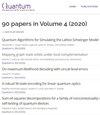通过单向横向CNOT门实现高效的容错码切换
IF 5.1
2区 物理与天体物理
Q1 PHYSICS, MULTIDISCIPLINARY
引用次数: 0
摘要
码交换是一种成熟的技术,它通过将两个QEC码与互补的门组合在一起,从而实现一组通用的FT量子门操作,每个门本身都易于实现容错。在这项工作中,我们提出了一种编码开关方案,该方案仅利用横向门来尊重傅立叶变换电路设计的约束。这些门本质上是傅立叶变换,没有额外的量子比特开销。我们分析了该方案在低距离颜色码中的应用,这些颜色码适用于现有的量子处理器,例如基于捕获离子或中性原子。我们简要讨论了基于超导量子比特的体系结构中出现的连接约束。电路级噪声的数值模拟表明,由我们的方案促进的逻辑$T$门可以在低物理错误率下优于flag-FT魔幻状态注入协议和物理$T$门。横向代码切换自然地扩展到任意代码距离的代码对。我们观察到与距离-3实现和物理门相比,距离-5协议在实际可实现的物理纠缠门错误率方面的性能有所提高。我们讨论了该方案如何在高度并行化的情况下实现,前提是逻辑辅助量子位可以足够可靠地准备。我们的逻辑$T$门规避了潜在的昂贵的魔法国家工厂。执行QEC和实现FT通用门集的要求基本上是相同的:离线准备逻辑辅助量子位,执行横向门并执行足够快的测量。因此,横向码交换有助于实现更实用的FT通用量子计算的硬件实现。该方案减轻了在逻辑量子比特上运行量子算法的实验演示对资源的需求。本文章由计算机程序翻译,如有差异,请以英文原文为准。
Efficient fault-tolerant code switching via one-way transversal CNOT gates
Code switching is an established technique that facilitates a universal set of FT quantum gate operations by combining two QEC codes with complementary sets of gates, which each by themselves are easy to implement fault-tolerantly. In this work, we present a code switching scheme that respects the constraints of FT circuit design by only making use of transversal gates. These gates are intrinsically FT without additional qubit overhead. We analyze application of the scheme to low-distance color codes, which are suitable for operation in existing quantum processors, for instance based on trapped ions or neutral atoms. We briefly discuss connectivity constraints that arise for architectures based on superconducting qubits. Numerical simulations of circuit-level noise indicate that a logical $T$-gate, facilitated by our scheme, could outperform both flag-FT magic state injection protocols and a physical $T$-gate at low physical error rates. Transversal code switching naturally scales to code pairs of arbitrary code distance. We observe improved performance of a distance-5 protocol compared to both the distance-3 implementation and the physical gate for realistically attainable physical entangling gate error rates. We discuss how the scheme can be implemented with a large degree of parallelization, provided that logical auxiliary qubits can be prepared reliably enough. Our logical $T$-gate circumvents potentially costly magic state factories. The requirements to perform QEC and to achieve an FT universal gate set are then essentially the same: Prepare logical auxiliary qubits offline, execute transversal gates and perform fast-enough measurements. Transversal code switching thus serves to enable more practical hardware realizations of FT universal quantum computation. The scheme alleviates resource requirements for experimental demonstrations of quantum algorithms run on logical qubits.
求助全文
通过发布文献求助,成功后即可免费获取论文全文。
去求助
来源期刊

Quantum
Physics and Astronomy-Physics and Astronomy (miscellaneous)
CiteScore
9.20
自引率
10.90%
发文量
241
审稿时长
16 weeks
期刊介绍:
Quantum is an open-access peer-reviewed journal for quantum science and related fields. Quantum is non-profit and community-run: an effort by researchers and for researchers to make science more open and publishing more transparent and efficient.
 求助内容:
求助内容: 应助结果提醒方式:
应助结果提醒方式:


